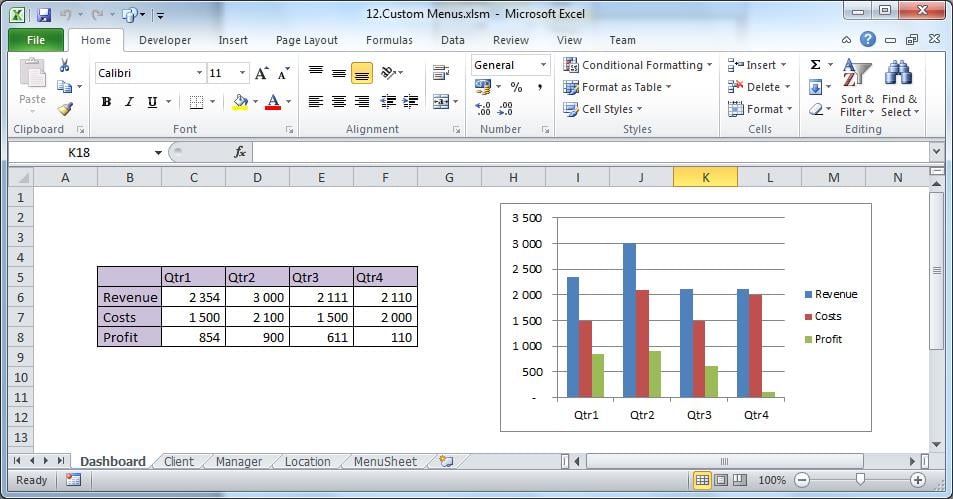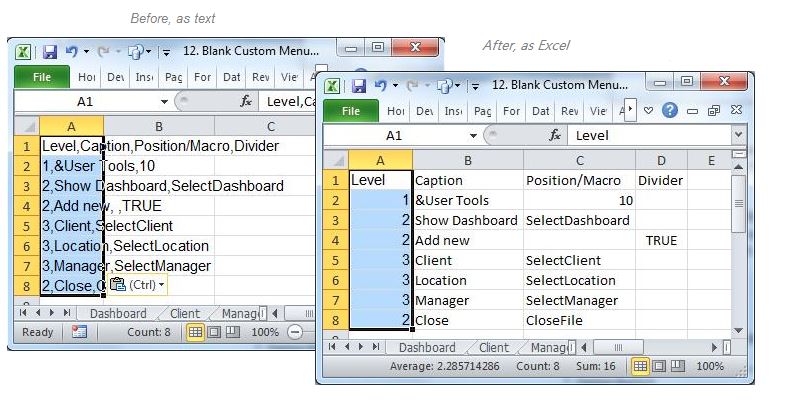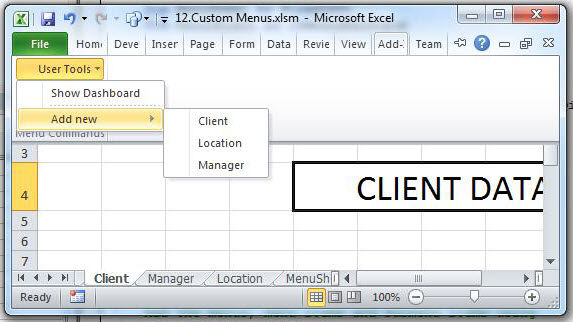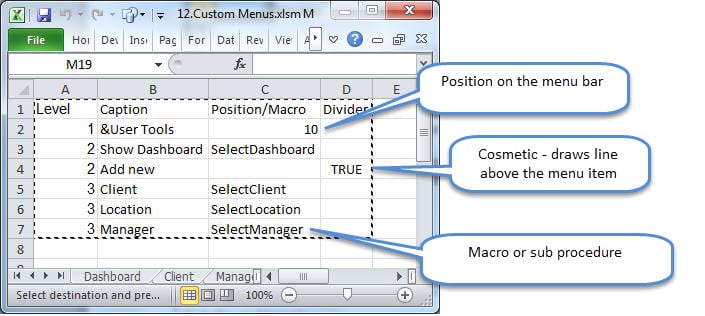The Excel ribbon can be modified to suit a particular job. This exercise creates new menus that point users to specific sheets relevant to their task.
In this article, we will introduce how to create customized menus in your Excel worksheet, like this: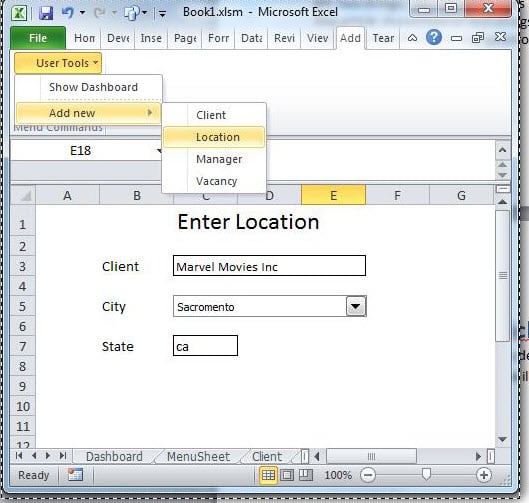
This article assumes the reader has the Developer ribbon displayed and is familiar with the VBA Editor. If not, please Google “Excel Developer Tab” or “Excel Code Window”.
Workbook
The workbook to be used has a number of sheets. We suggest you use the sample one found here. It looks like this.
The first four sheets are dysfunctional, being used in this exercise for navigation purposes only.
The fifth sheet will hold the customised menu structure particular to this workbook. At present it should be blank except for a Test button.
Add the Menu Structure
Copy the following block of text into cell A1 of the sheet “MenuSheet”.
Level,Caption,Position/Macro,Divider
1,&User Tools,10
2,Show Dashboard,SelectDashboard
2,Add new, ,TRUE
3,Client,SelectClient
3,Location,SelectLocation
3,Manager,SelectManager
2,Close,CloseFile
Format the Menu Structure
This CSV data ends up in column A. To format it into individual Excel cells, select column A and using ‘Text to columns’ in the Data tab. The delimiter would be “comma”.
The above, once we have added the appropriate code, will give us the level-based menu structure at left.
The first level, in this exercise, is arbitrarily placed as the tenth item on the menu bar, as you will see when the full width of the workbook is displayed.
Creating and Destroying Menus
Since we only want the new menus for this specific workbook, we will create and destroy them on opening and closing the workbook.
The code below is a start. It will be triggered when the workbook is opened or closed. Copy it into a module in your workbook
Assign the Test button on MenuSheet to Auto_Open.
Option Explicit Sub auto_Open() Call DeleteMenu Call CreateMenu End Sub Sub auto_Close() Call DeleteMenu End Sub
Below, we examine our menu structure more closely.
No macro is triggered by Add New because it has no function other than as parent of sub-menus.
This kind of menu structure is easy to maintain. Simply add new items with their macros, being conscious of the menu Level.
The Code
Append the following VBA code to the module. This will examine the “MenuSheet” and create the customised menu.
Sub CreateMenu()
' Called from Auto_Open. 'NOTE: There is no error handling in this subroutine
Dim MenuSheet As Worksheet
Dim MenuObject As CommandBarPopup
Dim MenuItem As Object
Dim SubMenuItem As CommandBarButton
Dim sRow As Integer
Dim MenuLevel, NextLevel, PositionOrMacro, Caption, Divider
Set MenuSheet = ThisWorkbook.Sheets("MenuSheet")
Call DeleteMenu
sRow = 2 ' start row
' Add menus using the structure as per the MenuSheet
Range("A" & sRow).Select
Do While ActiveCell > "" '****************
With MenuSheet
MenuLevel = .Cells(sRow, 1)
Caption = .Cells(sRow, 2)
PositionOrMacro = .Cells(sRow, 3)
Divider = .Cells(sRow, 4)
NextLevel = .Cells(sRow + 1, 1)
End With
Select Case MenuLevel
Case 1 ' Add the top-level menu to the Worksheet CommandBar
Set MenuObject = Application.CommandBars(1). _
Controls.Add(Type:=msoControlPopup, _
Before:=PositionOrMacro, _
Temporary:=True)
MenuObject.Caption = Caption
Case 2 ' A Menu Item
If NextLevel = 3 Then
Set MenuItem = MenuObject.Controls.Add(Type:=msoControlPopup)
Else
Set MenuItem = MenuObject.Controls.Add(Type:=msoControlButton)
MenuItem.OnAction = PositionOrMacro
End If
MenuItem.Caption = Caption
If Divider Then MenuItem.BeginGroup = True
Case 3 ' A SubMenu Item
Set SubMenuItem = MenuItem.Controls.Add(Type:=msoControlButton)
SubMenuItem.Caption = Caption
SubMenuItem.OnAction = PositionOrMacro
If Divider Then SubMenuItem.BeginGroup = True
End Select
sRow = sRow + 1
Range("A" & sRow).Select '***************************************
Loop
Sheets("Dashboard").Activate
End Sub
Sub DeleteMenu()
' This sub will be executed when the workbook is closing
Dim MenuSheet As Worksheet
Dim sRow As Integer
Dim Caption As String
On Error Resume Next
Set MenuSheet = ThisWorkbook.Sheets("MenuSheet")
sRow = 2
Range("A" & sRow).Select
Do While ActiveCell > ""
If MenuSheet.Cells(sRow, 1) = 1 Then
Caption = MenuSheet.Cells(sRow, 2)
Application.CommandBars(1).Controls(Caption).Delete
End If
sRow = sRow + 1
Range("A" & sRow).Select
Loop
On Error GoTo 0
End Sub
Sub SelectDashboard()
Sheets("Dashboard").Activate
End Sub
Sub SelectClient()
Sheets("Client").Activate
End Sub
Sub SelectLocation()
Sheets("Location").Activate
End Sub
Sub SelectManager()
Sheets("Manager").Activate
End Sub
Sub CloseFile()
MsgBox "Close! (write your own code in the module)"
End Sub
Test the code with the Test button. The newly created user menu will be found at menu position 10, under Add-ins.
Excel Recovery
Excel is unstable at times, and crashes while open, damaging the source file. Where it fails to recover the file, it is useful to have a tool to repair Excel damage otherwise all unbacked- up work will be lost.
Author Introduction:
Felix Hooker is a data recovery expert in DataNumen, Inc., which is the world leader in data recovery technologies, including repair rar and sql recovery software products. For more information visit www.datanumen.com
